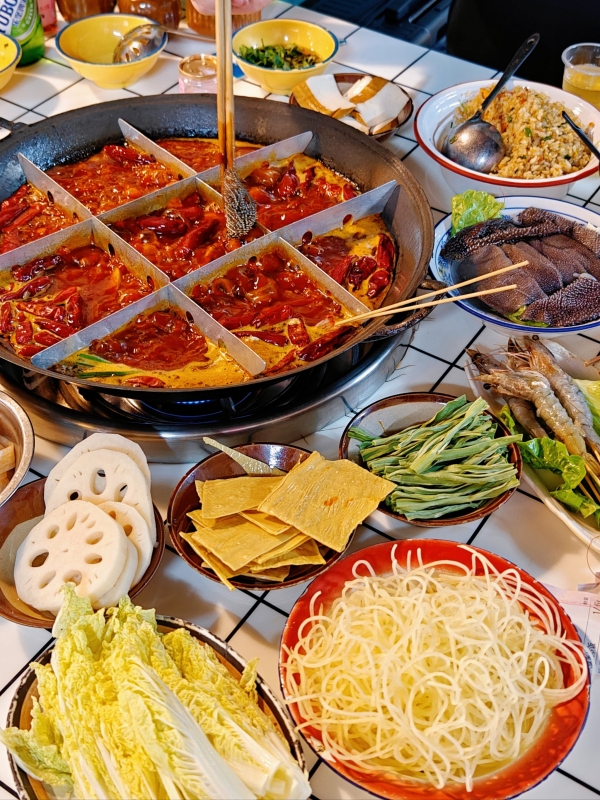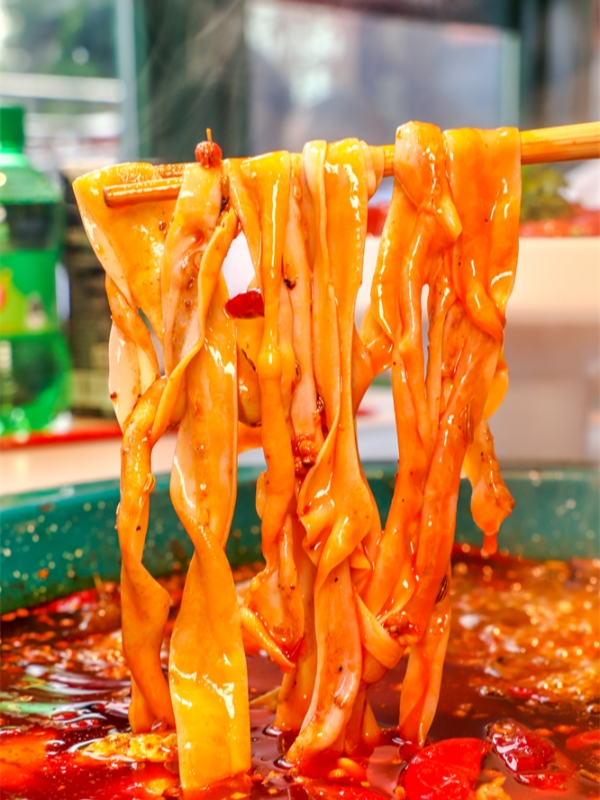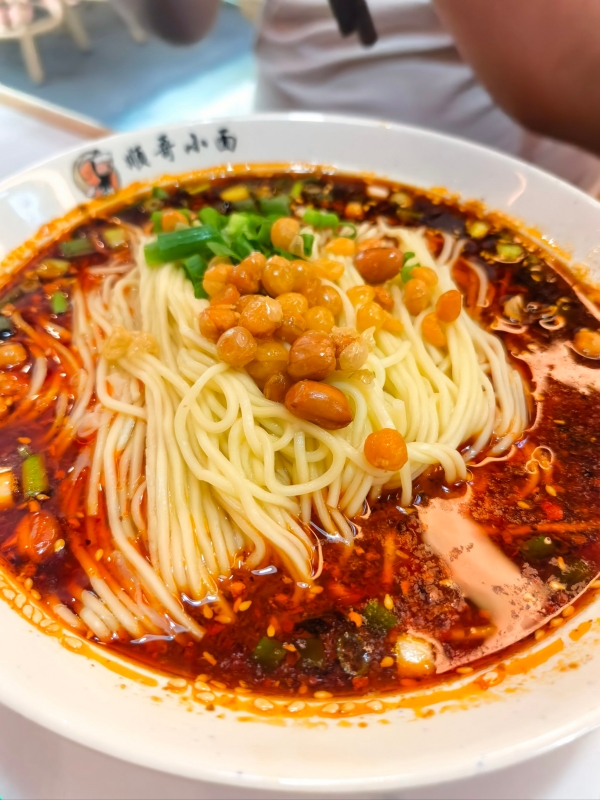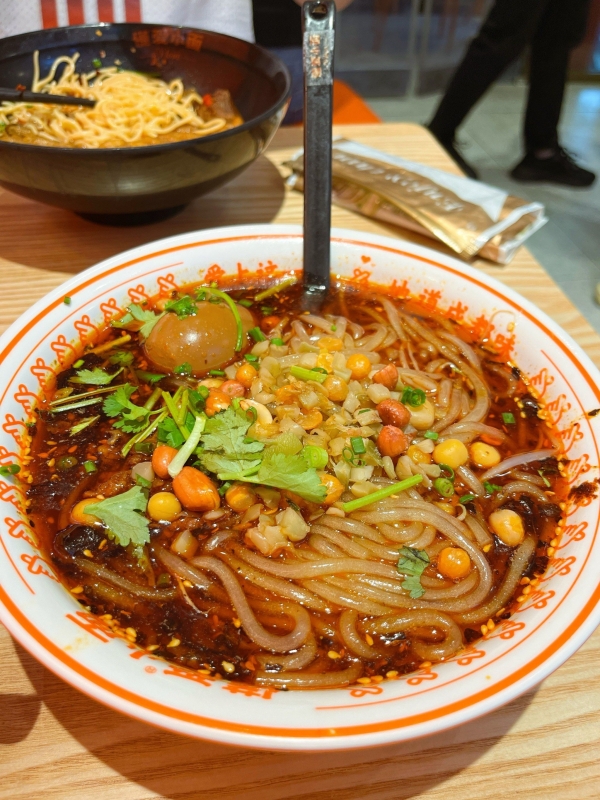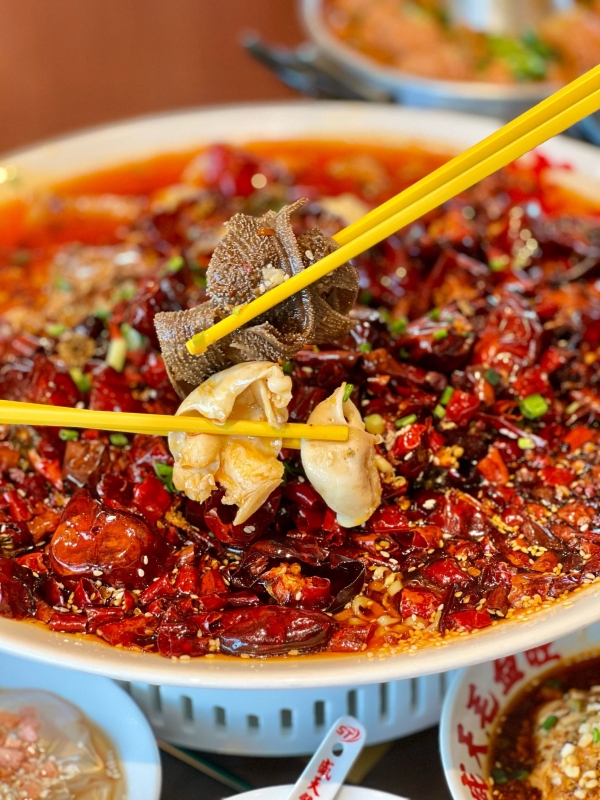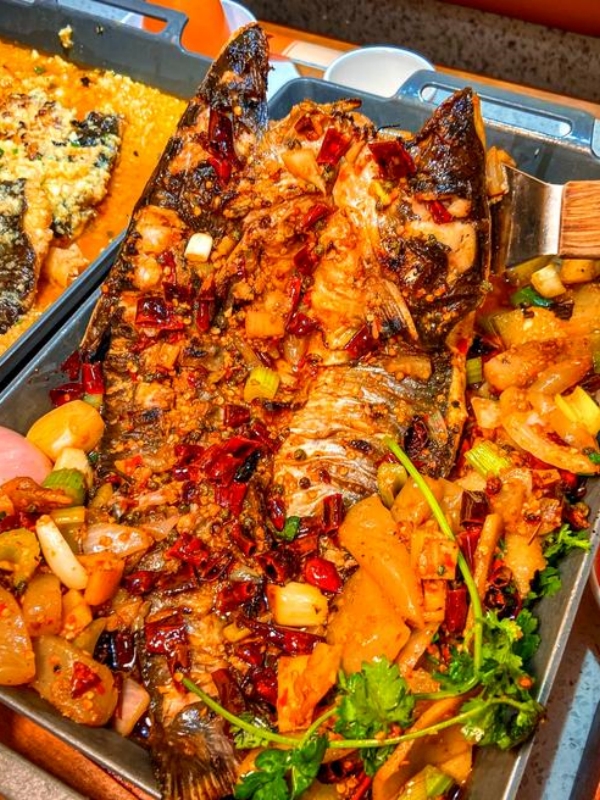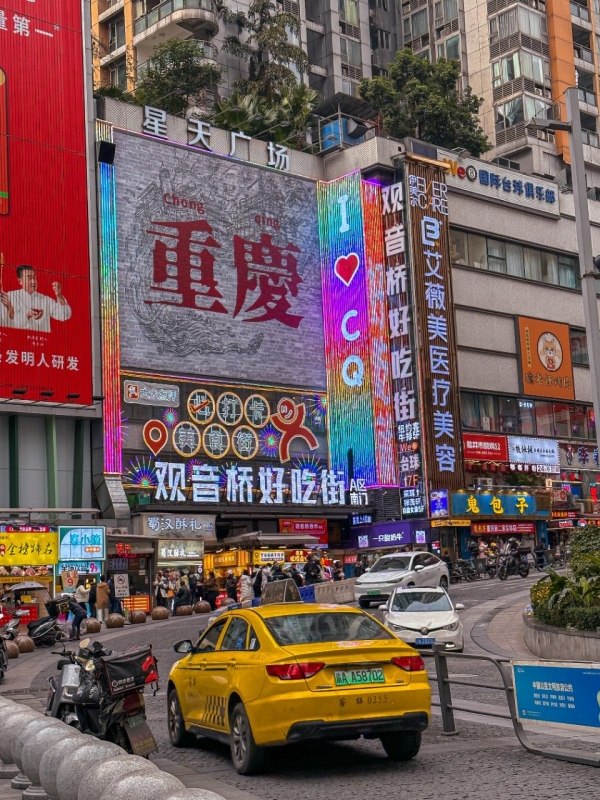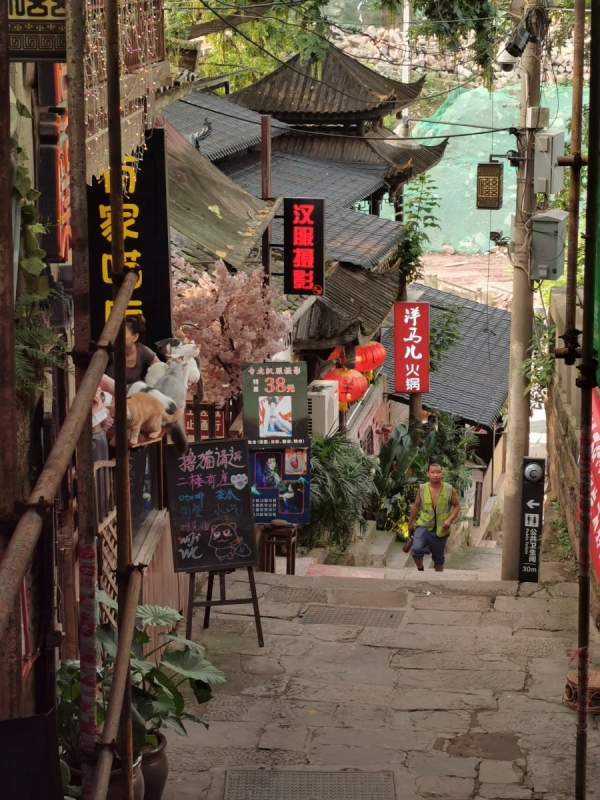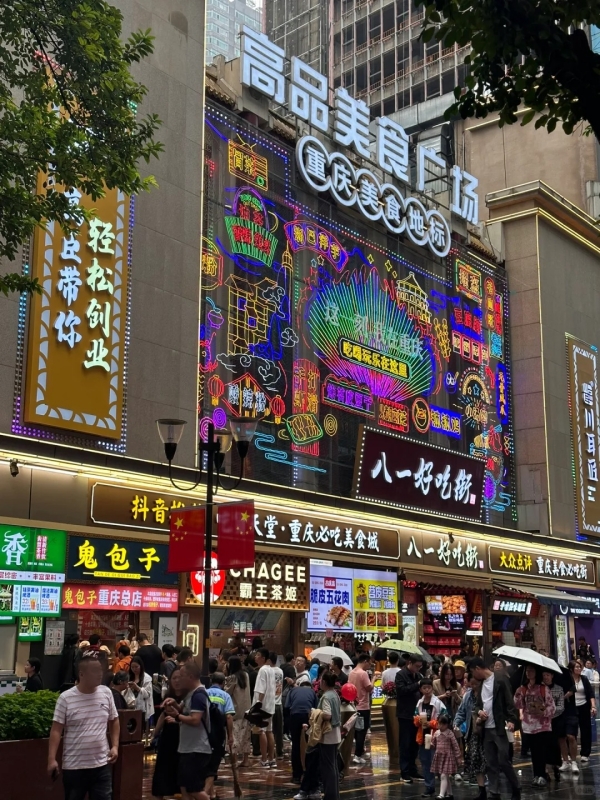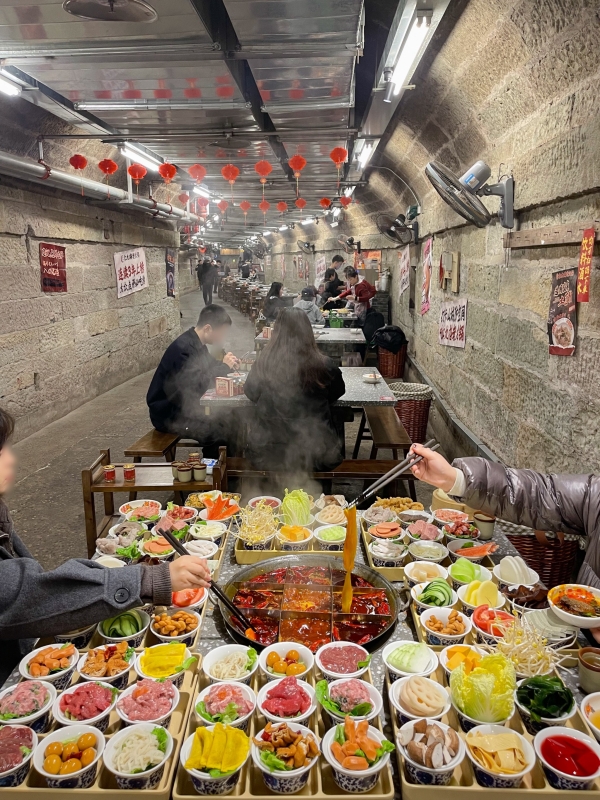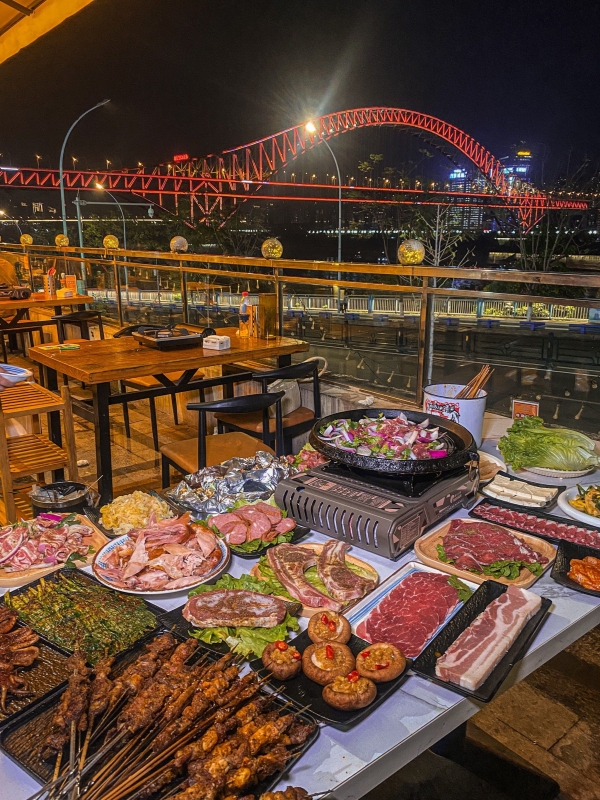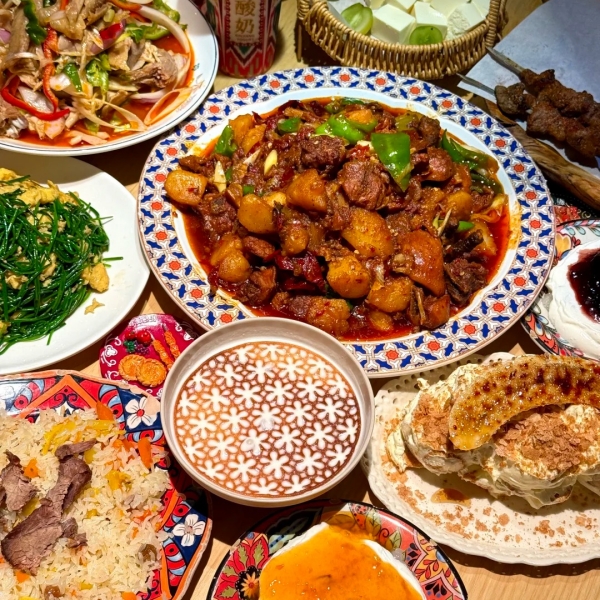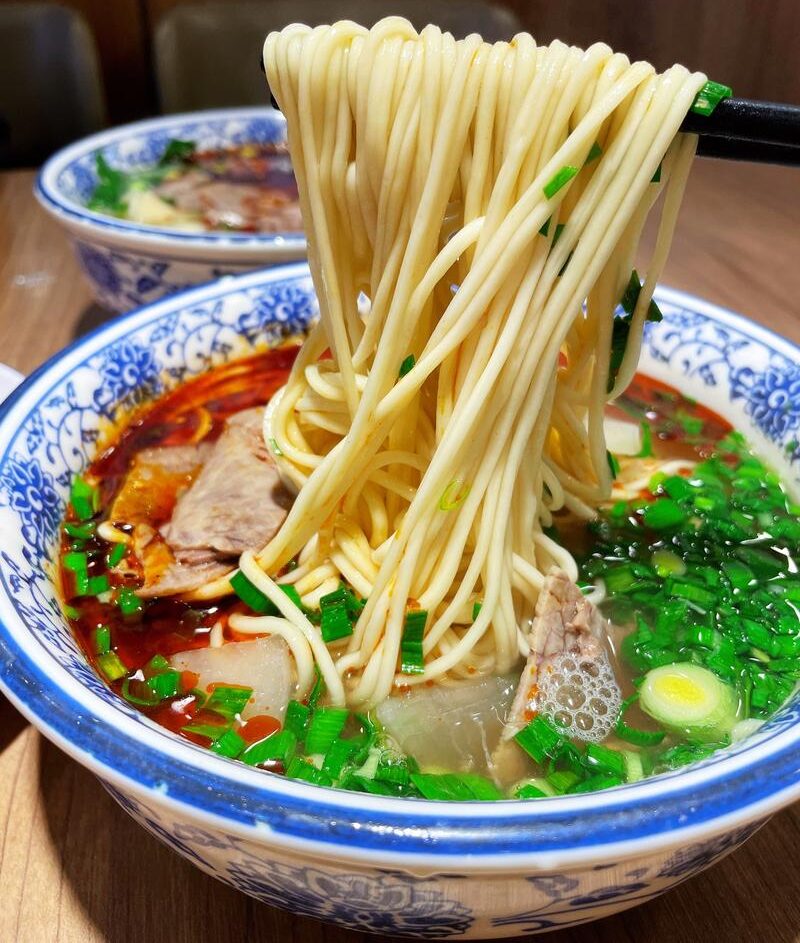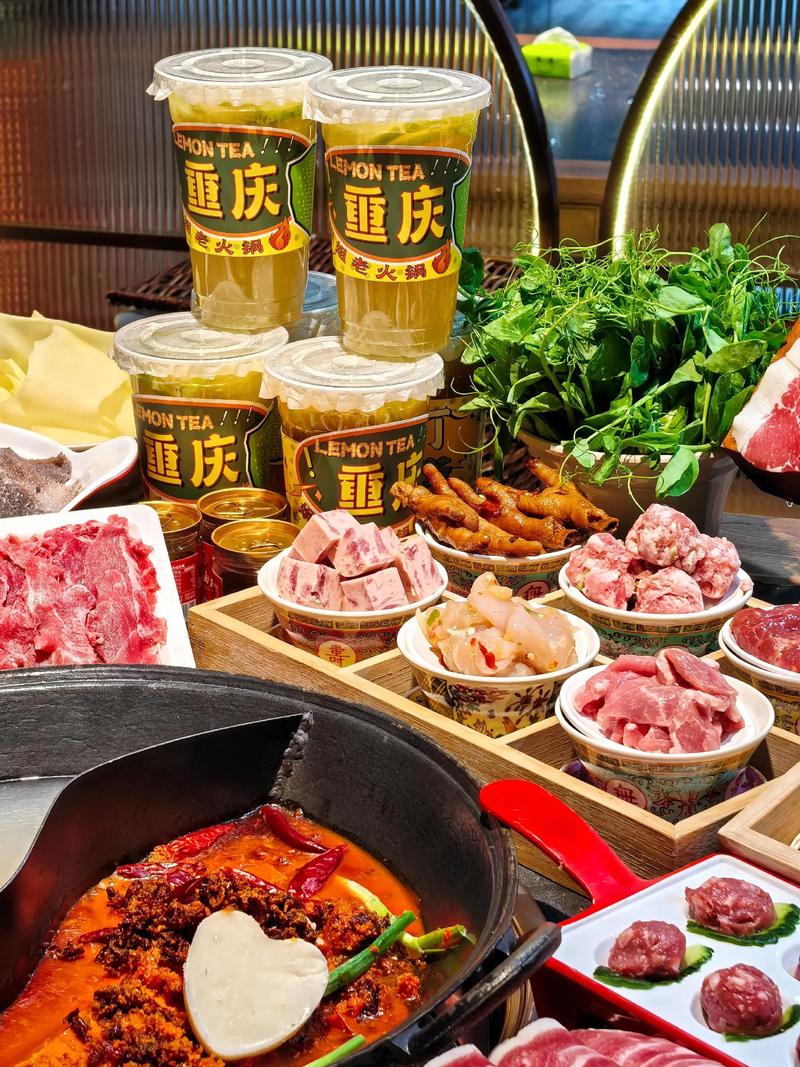
Chongqing Food
Málà and beyond. Spicy and numbing with attitude, serious heat on the street. No need for a spice game, simply comfort food. Shaped by a humid climate, a port city dockworker culture, and strong communal dining ethos, Chongqing food tastes growth on its own terms.
If you’ve wondered why the people of Chongqing have a strong commitment to their unique cuisine, this is the start of our real work here. From hotpot etiquette to small-noodle city strategy, this section takes you through all you need to know to smartly chow down. Sin city, the dim side of Chongqing awaits. Keep going.
The Chongqing Mala Philosophy - More Than Just "Spicy"
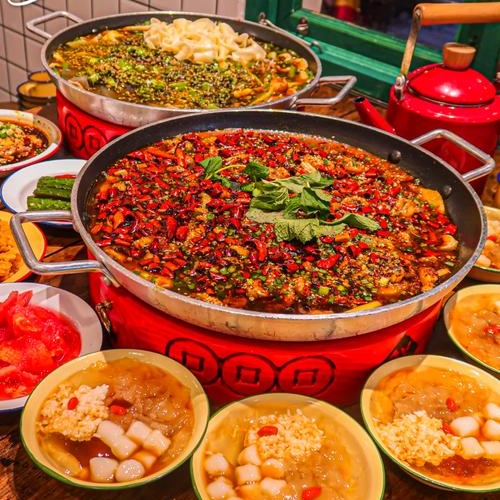
Chongqing Mala Food
Before you put Chongqing food in your mouth, understand one word: 麻辣 (málà). To define it as “spicy” is failing it entirely. Mala is the fusion of two different sensations: 麻 (má, numbing), most typically borne from the shock of Sichuan peppercorns, and 辣 (là, spicy hot), delivered by chilies/chili oil. Spicy chilies bring warmth. Numbing
Chongqing vs. Chengdu - The Sibling Rivalry
One question I get asked most often is “Wait, isn’t Chongqing part of Sichuan?” Technically, yes. Chongqing was aka part of Sichuan Province until 1997, when it became our country’s fourth direct-controlled municipality (after Beijing, Shanghai, and Tianjin). But even under their one province umbrella, the food scenes were already drifting apart.
Chongqing food is a full-contact sport—it features an EXTRA numbing + burning spice level, aggressive nine-grid hotpot, and heavy beef tallow. In contrast, Chengdu cuisine is culinary art, characterized by a refined chef personality, balanced sweetness, and elegant hotpot using clear oil. But for essential differences beyond the plate, please consult Chengdu vs Chongqing Essentials: Panda Calm or Mountain Fire for Short Trips to find more travel details.
The Must-Try Dishes - Define Chongqing’s fiery food culture
- Chongqing Nine-grid Hotpot
- Duck Intestines
- Chongqing Xiao Mian
1. Chongqing Hotpot (火锅) - The Non-Negotiable Experience
🌶️🌶️🌶️🌶️ | ¥80-300 per person | Best time: Dinner (7pm-midnight)
Imagine in your mind a steaming pot of metal divided into nine compartments, each filled with bubbling bright red chili oil so hot you can feel the fiery heat three feet away. Star anise and cinnamon bark bobbing in the mix like tiny ships in a dangerous ocean. Sichuan peppercorn brewing on the edges. And somewhere in all that fire and fury lies a broth so rich it’s been stewing for 48 whole hours with beef tallow, rendering it down until it’s so fragrant you might as well bottle it as perfume.
This is what’s known as 九宫格火锅 jiǔ gōng gé huǒguō reduced to nine grids in Chongqing hotpot. It is your science experiment, your social experiment, and maybe even an act of world’s most volitional torture.
The essential secret to eating hotpot like a local revolves around ingredient hierarchy: first you start with the毛肚 (máo dǔ, tripe)—if it’s not fresh and crunchy, get out of that restaurant. Next is the鸭肠 (yā cháng, duck intestines), which must be slaughtered on the same day or locals won’t touch them. After that comes the黄喉 (huáng hóu, beef aorta), which sounds horrific but has all the toothiness of a mound of al dente pasta. Then just strap in and work your way through the menu: beef slices, then lamb rolls, potato slices, winter melon, and if you’re feeling brave 脑花 (nǎo huā, pigbrain) nice and creamy and sinful as the world’s most controversial kullanılabilir custard!
2. Chongqing Xiao Mian (重庆小面) - Breakfast of Champions
🌶️🌶️ | ¥8-20 per bowl | Best time: 7-10am
At 7am in Chongqing, the streets are alive with one distinctive noise: slurp-slurp-slurp as people inhale alfalfa noodles out of bowls as if doing so would make physics itself bend. The small noodles known as 小面 (xiǎo miàn) are more than just breakfast in Chongqing – they’re a ritual, a test of civic identity, and a social leveler: CEOs in three-piece suits sit shoulder to shoulder with construction workers in a bowl-in-the-wall, eyeing their bowl with exactly the same speed and focus.
The Chongqing populace are thought to munch through about 8 million bowls of the stuff each day – more than whole countries do in a week! So what goes into a great bowl of small noodles? Not just one element, but a system of 24 seasonings and different other ingredients. The base sauce will typically be a mix of soy sauce, black vinegar, oil with that special flavor of Sichuan pepper, chili oil, and a ginger-garlic water that smells like jet fuel and tastes of bliss.
That’s followed by your toppings: bits of the preserved mustard greens known as碎米芽菜, for their hot crunch; a spoonful of fat; a sprinkling of scallions; blobs of lard (猪油). Finally, and this is the best bit, pork which has been fried with fermented soybean to give a dark flavor approaching caramel.
Chongqing Street Food - The Night Market Playground
- Suanla Fen
- Lazi Ji
- Mao Xue Wang
3. Suanla Fen (酸辣粉) - The Sweet Potato Glass Noodles
🌶️🌶️🌶️ | ¥8-15 per bowl | Anytime snack
Imagine if noodles were made of sweet potato starch, translucent, chewy, and somehow bouncy like tiny springs, floating around in a crimson broth. The first time you have 酸辣粉 (suān là fěn), your brain gives up trying to figure out the physics of shape, slippage, and resistance as you bite down repeatedly on these slippery but grippy, soft but tough nuggets of chewy goodness, so unlike any wheat or rice noodle.
The magic is in the name: 酸 (suān, sour) from the black vinegar and pickled vegetables, 辣 (là, spicy) from the chili oil, and Sichuan peppercorns, and 粉 (fěn, noodles), made from sweet potatoes. This dish originated in Zigong, Sichuan, but it was the people of Chongqing who brought it to perfection, and you can find aunties on any street corner hand-making fresh noodles using a special tool that looks like an upside- down giant colander full of holes.
4. Lazi Ji (辣子鸡) - The "Find the Chicken" Challenge
🌶️🌶️🌶️🌶️ | ¥45-80 per plate | Dinner or late-night
If Chongqing food had a sense of humor, 辣子鸡 (là zǐ jī) would tell the best joke! A giant serving plate arriving piled high with 200-300 dried red chilis - your task is to find the chicken hidden beneath. Less a dish, more a treasure hunt with chopsticks whilst your eyes water from the chilli fumes alone!
Lazi Ji falls within the category of 江湖菜 (jiāng hú cài) i.e. “Rivers and Lakes cuisine”, which developed from the gikan restaurants along the roadside serving up truckers and day labourers outside big cities in the 1990’s. Dishes are purposely vulgar, made for sharing over beer and rambling, and sweat! A cuisine that makes you cry, perspire, laugh, and cry out to your parents for advice all at the same time.
The technique you need, is to ease your chopsticks into the mountain of chilis to go treasure hunting for the brown morsels within. When you locate a morsel the exterior must be crunchy, and the juicy interior to not play second fiddle when it comes to flavour, laced with caramelised garlic, buttery sweet, numbing peppercorns, clothed with chilli oil, and searingly hot.
5. Mao Xue Wang (毛血旺) - The "Blood Prosperity Pot"
🌶️🌶️🌶️ | ¥35-60 per pot | Lunch or dinner
Yes, “blood prosperity pot” is a perfect English translation of the dish's name. Duck blood is the star ingredient, but before you close this browser tab let me convince you: 毛血旺 (máo xuè wàng) is one of the most texturally interesting dishes in Chinese cuisine, and tastes absolutely nothing like what you think blood would taste like.
This is pure dock culture, a hodge-podge of cheap ingredients tossed in a numbing-spicy broth. Duck blood arrives as dark reddish-brown cubes with the texture of silken tofu, completely neutral tasting and existing in the dish mostly as a sponge for the surrounding sauce. Add to that tripe (crunchy), eel (tender), lunch meat (yes, Spam-like lunch meat is considered a delicacy), bean sprouts (fresh crunch), and mushrooms, all bobbing in a thick oily broth flavored with Sichuan peppercorns, chili oil, garlic, ginger, and fermented soybeans.
The name comes from the method of cooking: 毛 (máo) means rough or hairy, which describes tripe, 血 (xuè) of course means blood, and 旺 (wàng) means prosperity – so they say, because it looks like the blood cubes are prospering (multiplying) in the pot. The real story is simpler, it’s dock food, meant to use the lowest of low materials and make them taste amazing through sheer will of spice and oil.
Beyond the Basics - Hidden Chongqing Flavors
- Roasted Fish
- Chongqing Cold Noodles
- Cold Shrimp
6. Roasted Fish (烤鱼) - Wanzhou's Gift to Chongqing
🌶️🌶️🌶️ | ¥120-180 for 2-3 people | Dinner
This dish doesn’t make sense on paper, but deliciously works in real life. Take a whole fish, butterfly it, throw it on a grill until smoky and charred, then cut into pieces and let it simmer in spicy broth tableside along with a medley of vegetables and tofu. Think of it as someone slammed BBQ, hotpot, and fish stew into a wall to see what came out: a glorious chimera!
万州烤鱼 (Wànzhōu kǎoyú) originally hails from Wanzhou, a riverside district famous for fish sale. Chongqing restaurants have perfected the version you’ll dream of for years. The fish (usually a meaty fish called 清江鱼, Qingjiang fish with fewer bones) is cleaved down the middle, opened up flat with the spine on the opposite side, seasoned with cumin and chili powder, then roasted over charcoal until the skin is crispy and the flesh just cooked through.
Then comes the transformation: the fish is poured into a metal pan along with bean sprouts, slices of lotus root and chunks of potato and tofu skin, then flooded with your sauce of choice –麻辣味? (numbing-spicy),泡椒味? (pickled pepper, or sour-spicy), or蒜香味? (garlic, the mildest). The pan goes on the table burner, and everything simmers together while you eat, with the vegetables soaking up fish flavor and spice while the fish flesh stays moist.
7. Chongqing Cold Noodles (凉面) - Summer Salvation
🌶️ | ¥6-10 per bowl | Lunch or snack, May-September
When Chongqing summer temperatures hit 38°C (100°F) and the humidity makes you feel like you're breathing through a wet towel, locals turn to 凉面 (liáng miàn) – cold noodles that somehow manage to be cooling and spicy at the same time. Picture room-temperature alkaline noodles tossed in a sauce made from sesame paste, chili oil, black vinegar, sugar, and soy sauce. The sesame paste gives it a creamy, almost peanut-butter-like coating. The chili oil provides gentle heat. The vinegar adds brightness. And the noodles themselves have a springy, bouncy texture that's infinitely satisfying to chew.
The texture is everything here. Good cold noodles should be 提黄 (tí huáng) – pulled from the water early and immediately shocked in cold water so they stay firm and separate. Bad cold noodles turn into a gummy mass of sadness that sticks to your teeth.
Old-school Chongqing locals eat cold noodles paired with a bowl of 冰粉 (bīng fěn, ice jelly) – a dessert made from the seeds of a plant in the physalis family, mixed with brown sugar, peanuts, and dried fruit. The combination of spicy-creamy noodles and sweet-cold jelly is the culinary equivalent of a cold shower on a brutal summer day. You can find this combination at street stalls for about ¥15 total during the summer months.
8. Cold Shrimp (凉虾) – The Sweet Antidote
🌶️ | ¥5-8 per bowl | Dessert or Cooling Snack, Year-round |
Often confused with the savory Cold Noodles, 凉虾 (liáng xiā) is purely a dessert—and the perfect foil to Chongqing's punishing spice and heat. Despite the name, there are no actual shrimp involved. The 'shrimp' refers only to the shape of the rice paste, which is squeezed through a colander directly into ice water, causing the cooked rice pulp to instantly solidify into short, curved, shrimp-like tails.
This uniquely textured base is then immersed in a simple yet powerful sweet soup: brown sugar syrup (红糖水), often infused with ginger or chrysanthemum for depth. It is typically served ice-cold.
The magic of liang xia lies in its simplicity and texture. The rice pieces are silken and slightly chewy (Q-texture), gliding down the throat effortlessly. It serves the same purpose as its cousin, 冰粉 (bīng fěn, ice jelly), by using the cooling effects of brown sugar water and ice to instantly soothe a burning tongue. While bing fen offers the added complexity of nuts and dried fruit, liang xia provides a pure, clean, and refreshing sweetness that makes it the ultimate year-round palate cleanser after a fiery meal.
- Guanyinqiao
- Ciqikou Ancient Town
- Bayi Snack Street
Finding great food in Chongqing isn't hard – the city has food on every corner. Finding great food at fair prices without falling into tourist traps? That requires a bit more strategy.
Guanyinqiao (观音桥) - Local Living Room
This is where Chongqing people actually eat. Guanyinqiao is a massive shopping and residential district in Jiangbei, packed with restaurants that have been serving locals for 20+ years. Prices here run about 40% less than Jiefangbei for equivalent food, and the quality is often better because restaurants survive on repeat business, not tourist foot traffic.
The 观音桥步行街 (Guanyinqiao Pedestrian Street) is the main drag, but the real treasures are in the back alleys. Walk away from the bright signs and follow the crowds of locals. You'll find small noodle shops, grilled skewer stalls, and hole-in-the-wall hot pot places with lines out the door during dinner hours (6-10pm is prime time).
Ciqikou Ancient Town (磁器口) - Heritage Snack Hub
Ciqikou is Chongqing’s most beloved ancient neighborhood, with Ming and Qing architecture and cobblestone streets climbing a hillside. It’s picturesque, historic, and full of tourists on the weekends and holidays.
The food situation here is a bit of a mixed bag: the main pedestrian street is mostly souvenir shops, selling vacuum sealed snacks at a huge mark-up (that being said, 陈麻花 [Chen Mahua] sells pretty delicious twisted dough for only ¥25 per bag because they’ve been in business for centuries). Venture further into the back streets and family-run restaurants that locals frequent, and you’ll find home-cooked authentic Chongqing food that is going to be more enjoyable.
Jiefangbei (解放碑) - Tourist Central
Let's be honest: Jiefangbei is convenient but overpriced. This is Chongqing's main commercial district, centered around the Liberation Monument, with shopping malls, hotels, and restaurants that cater to out-of-towners. You'll find English menus, international payment options, and staff who can sort of communicate in broken English. The trade-off? Prices are inflated by 30-50%, and many restaurants prioritize Instagram aesthetics over food quality.
That said, if it's your first night in Chongqing and you're jet-lagged and overwhelmed, Jiefangbei is a safe landing zone. 八一路好吃街 (Bayi Snack Street) has 30+ small food stalls packed into one alley, serving everything from stinky tofu to grilled squid to bubble tea. It's touristy, sure, but it's also open until 3am and offers free samples at many stalls, making it easy to try before you buy. Jiefangbei is the perfect "safe landing zone" for your first night, and for a comprehensive look at what makes this district tick 24/7, read Jiefangbei Square: Chongqing’s Urban Heart of Neon, Hotpot, and Human Stories.
University District (大学城) - Budget Gourmet Paradise
Chongqing University's south gate area is my favorite place to eat when I want maximum flavor for minimum money. University neighborhoods worldwide have great cheap food, but Chinese universities take it to another level. Here you can get a legitimately delicious dinner for ¥10-20, with portions sized for the bottomless stomachs of 20-year-olds.
重大南门 (Chongqing University South Gate) has 50+ small restaurants lining the street, most open until 2am (extending to 3am during exam seasons when students study all night). Try the 碗碗羊肉 (bowl-bowl lamb) – tender lamb pieces in a personal clay pot with cumin and chili, ¥15 per bowl. Or hit up the barbecue stalls that set up around 8pm, where you can assemble your own skewer selection for ¥30-40 and eat more than you should.
Special Food Experiences - Beyond the Plate
- Air-Raid Shelter Hotpot
- Riverside BBQ at Chaotianmen
- Local Spot of Chongqing Food
Air-Raid Shelter Hotpot (防空洞火锅) - WWII Dining
Here's something you won't find in many other cities: restaurants built inside actual World War II air-raid shelters carved into Chongqing's mountainside. Eating hotpot in a cave is surreal. Stone walls drip with condensation. The sound of boiling broth echoes off ancient rock. Dim yellow lights barely penetrate the darkness.
五一路防空洞火锅 (Wuyi Road Air-Raid Shelter Hotpot) is the biggest and most famous, capable of seating 200 people in multiple connected caverns. At ¥120 per person, it's priced like a mid-range restaurant but offers an experience you literally can't get anywhere else. Bring a light jacket – going from steamy summer streets into a 20°C cave is a shock to the system.
Riverside BBQ at Chaotianmen (朝天门江边烧烤) - Smoky · Lively · Spicy
Once the sun sets and temperatures drop, vendors start setting up BBQ stalls along the Jialing River near Chaotianmen port. By 8pm, the whole riverside is packed with locals sitting on plastic stools, drinking beer, and working their way through mountains of grilled skewers.
This is peak summer nightlife in Chongqing: river breeze carrying the smell of charcoal and cumin, the lights of the city reflected in the black water, and the universal language of "one more round of skewers, please." For ¥50-80, you can eat until you waddle.
Follow the Aunties (跟着大妈走战略) - Watch · Imitate · Enjoy
Here's my secret weapon for finding incredible food: follow middle-aged and elderly local women in the morning. Sounds weird, I know. But Chinese aunties (大妈, dàmā) are food ninjas who've been eating at the same breakfast spots for 30+ years. They know which noodle stall uses fresh ingredients, which shop changed ownership and went downhill, and which vendor gives better portions.
The methodology: between 6-7am, position yourself near a residential area (not a tourist zone) and watch where groups of aunties are heading. Bonus points if they're wearing pajamas and slippers – that means they live so close they didn't bother changing, which means they're eating at their absolute favorite local spot. Follow them at a respectful distance, observe what they order, then point at their food and hold up one finger when it's your turn.
The Spice Survival Guide
First, understand that Chongqing's mild spicy (微辣, wēi là) equals most other cities' medium spicy. Their medium (中辣) is hot enough to make experienced spice-eaters sweat. And their heavy spicy (重辣) is an advanced martial arts technique that should not be attempted by foreigners without training. Even locals sometimes order 微辣 and add extra chili oil at the table if they want more heat.
What doesn't work: cold water spreads capsaicin around your mouth like oil on water, making it worse. Beer (啤酒) contains alcohol that intensifies the burning sensation. And plain rice without fat doesn't absorb enough heat to help. If you're in pain, ask for 豆奶 (dòu nǎi, soy milk) or 冰粉 (bīng fěn, ice jelly).
Budget Planning
Daily food expenses in Chongqing can range from backpacker-level cheap to luxury dining, depending on your choices. Here's a realistic breakdown.
| Budget Level | Daily Range (¥) | Key Meal Examples | Amenities |
| Budget Traveler | ¥50-80 | Small noodles, fast-food/small restaurant lunch, street-side hotpot/BBQ | Cheap, good food, no fancy settings |
| Mid-range | ¥150-250 | Tofu pudding rice, sit-down stir-fry lunch, proper hotpot | A/C, clean bathrooms, choice of multiple dishes |
| Luxury | ¥400+ | High-end hotpot, upscale Sichuan restaurant, hotel afternoon tea | Premium ingredients, ambiance, English-speaking staff |
Money-saving tips: eat your biggest meal at lunch when restaurants offer 午市套餐 (lunch set menus) at 30% off. Use food delivery apps like 美团 (Meituan) or 饿了么 (Ele.me) to get restaurant food at near-street prices. And avoid weekends and holidays when prices jump 20-40% due to demand.
When to Eat - Chongqing's Food Clock
Chongqing has specific eating rhythms that differ from Western schedules. Understanding them helps you avoid crowds and get the freshest food.
6-9 am (Small Noodle Time):
- Focus: Breakfast is eaten out, primarily small noodles.
- Guidance: Go between 7-8 am for the freshest noodles. Most stalls close by 9:30 am.
11 am-1 pm (Lunch Rush):
- Focus: Restaurants offer cheapest 套餐 (set menus), often 30-40% off.
- Guidance: Take advantage of set menus. Avoid 12-1 pm in tourist areas to skip the worst crowds.
6-9 pm (Dinner Prime Time):
- Focus: Peak time for hotpot; popular places have long waits.
- Guidance: Book ahead, arrive before 5:30 pm, or wait until after 9 pm to avoid the 1-2 hour wait times.
9 pm-2 am (Night Snack Culture - 夜宵):
- Focus: BBQ, "second dinner" noodles, and riverside dining.
- Guidance: Peak time for 串串 (chuàn chuàn, small skewers) and cold beer.
Frequently Asked Questions: What You Should Know about Chongqing Food
Q: What is the famous food in Chongqing?
Chongqing’s famous foods include hotpot, small noodles, and jianghu dishes, and these staples define the city’s bold style. After that quick point, the details show how locals love rich oil, strong málà, and fast heat that still stays balanced. Street snacks like sour-spicy glass noodles, roasted fish, and skewers keep prices low and flavors loud. Travelers chase chewy, crispy, and slippery textures in one meal, so every bite feels fun and unforgettable.
Q: Is Chongqing part of Szechuan?
Chongqing no longer belongs to Sichuan, and it now operates as a direct-controlled municipality with a clear food identity. From that base, differences stand out when Chongqing cooks push stronger heat, heavier oil, and beef-tallow broths, while Chengdu chefs lean toward softer balance. The two cities stay linked by history, yet their bowls show different spice rhythms and aroma levels. Travelers notice these contrasts fast, especially when walking through crowded streets filled with smoky stalls.
Q: Is Chongqing food very spicy?
Chongqing food brings strong heat, but most restaurants let you choose spice levels, so the fire never traps you. After that simple point, details show how locals start with 微辣 to warm up before jumping higher. Hotpot spots serve split pots with spicy and mild broths, so groups handle limits without stress. If you avoid heavy heat, you still get safe picks like clear-broth hotpot, tofu pudding rice, or sour-broth dishes.
Q: What does Chongqing taste like?
Chongqing tastes loud with strong málà tones that mix chile heat and peppercorn numbness in one fast punch. That clear point sets the mood, and deeper layers show how fermented beans, MSG, garlic, and rich oil build heavy umami. The flavor hits in waves, pushing aroma after heat and ending with a soft tingle. Textures stack easily because locals love chewy beef, crispy toppings, slippery noodles, and soft vegetables in one bowl.
Q: How do I find good food in Chongqing?
You find good food in Chongqing by asking locals since hotel staff and taxi drivers offer reliable advice. After that clear answer, details help you use Dianping to check ratings, distance, and busy hours. Street spots with long lines usually serve stronger flavors, so crowds guide you well. Tourist zones charge more, so skip glossy places. Tell your hotel “我想吃本地人吃的地方” for real gems, then explore side streets for great stalls.
